Petra in Jordan: Complete Travel Guide to the Lost City
1- Why Petra Should Be on Your 2025 Travel List
For those in pursuit of a vacation filled with awe-inspiring habitats, stunning ruins, and rich history, what better destination to have for 2025 than Petra, Jordan? This Petra Jordan Travel Guide introduces you to the Rose-Red city, which is located in the southern region of Jordan and is distinguished by the chalky sandstone bare rock rising and carved superbly from it.
Wandering into Petra Jordan Travel Guide while in the year 2025 is quite a necromancy in itself, as the council of Jordan concentrates on eco-tourism and far-reaching improvement of the tourism standards. The city center of Wadi Musa has been restructured, especially the town’s Junction, which is an entrance to the city. Memory sites have been interpreted by local expert guides there, and activities like Petra by Night tend to also amaze the tourists quite easily.
I think one of the things that makes Petra exceptional is the mix of amazement and closeness. The elongated Siq appears as a lane at the start of the day. You may be mesmerised by the first glimpse of the Treasury glowing in yellow colours. Or how about a strenuous hike up to the Monastery with the only things in sight being the blowing of wind and rocks around you. And it is not mere sightseeing. It is more like being transported to the past, where people wore togas and sandals and other such stuff.
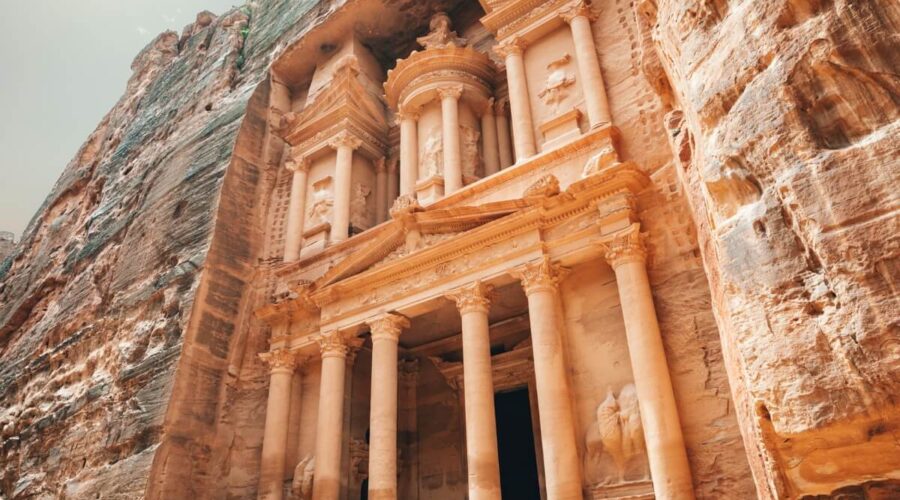
2- A Brief History of Petra, Jordan
Petra Jordan Travel Guide is a place rooted in tradition, and so it cannot fail to have a rich, ancient history that made it what it is in the present time. Petra, Jordan Travel Guide was the capital of the Nabataeans around 400 B.C., who were known for their hydraulic engineering, architecture, and trade in spices. The city successfully developed due to its advantageous location near the old trade routes where products like spices were brought via the incense and silk roads, among others, connecting the Arabian Peninsula, Egypt, and the Mediterranean countries. As a result, Petra gained significance as an influential commercial city that attracted merchants and other travelers engaged in trade.
With riches at their disposal, the Arab traders of Petra gave the world nothing less than monumental edifices hewn directly out of the towering sandstone cliffs tinted with hues of red. The result that they achieved was no less than an incredible city replete with carved caves, sanctuaries, and façades, which, according to Nabataean artistic ambitions, also included Roman and Hellenistic features. The most striking example was the Treasury (Al-Khazneh) – an astounding entrance that greets patrons emerging from the narrow gully.
The Rise, Fall, and Rediscovery of Petra
For countless years, Petra stood as an economic symbol till a group of factors made it start to deteriorate. Several quakes demolished some main constructions, and as new commercial roads ignored the place, Petra started losing its relevance rather quickly. Up to the Middle Ages, what once was a lively city had long become empty, known only to a few residential Bedouins who still kept its secrets.
It was in the year 1812 that the Swiss voyager Johann Ludwig Burckhardt brought back to the Western world the fame Petra had enjoyed a long time earlier, giving rise to awe that never dies to this day. At present, Petra is known as a World Heritage Site of UNESCO and one of the New 7 Wonders of the World, and one of the topmost archaeological sites in the world. The pleasures of such a compendium are not only a bringing back of the past but also a fascinating interaction with the city, which has, against all odds, survived for thousands of years.
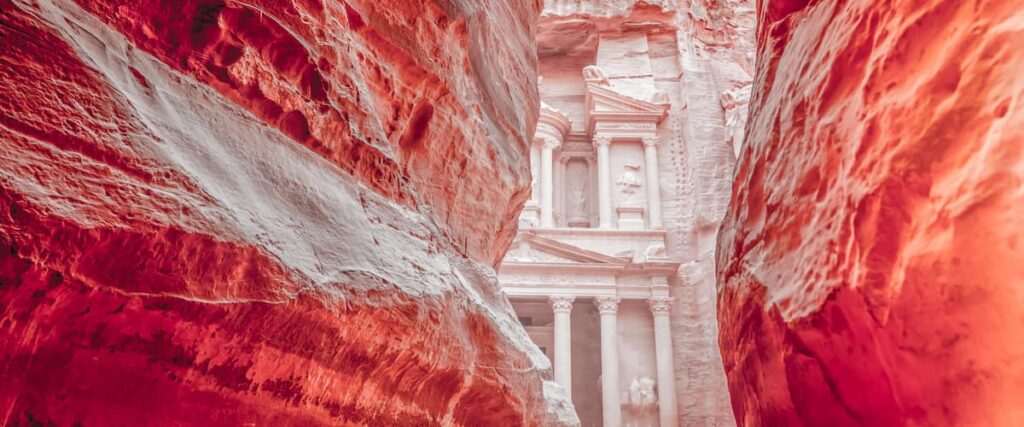
3- How to Get to Petra
One of the most practical parts of this Petra Jordan travel guide is understanding how to reach the site. Petra is located in southern Jordan, just beside the modern town of Wadi Musa, which serves as the gateway to the archaeological park.
From Amman
-
By Car: The most flexible option is to rent a car and drive yourself. The journey takes about three hours via the Desert Highway. Along the way, you’ll pass through stretches of open desert and can stop at scenic viewpoints or small roadside cafés.
-
By Bus: JETT buses provide a convenient and budget-friendly option, leaving from Amman early in the morning and returning in the evening. These buses are comfortable and widely used by tourists.
From Aqaba
If you’re coming from Aqaba, Petra is about two hours away by car. Many visitors traveling from the Red Sea resorts include Petra as a day trip, thanks to the shorter travel time.
Guided Tours and Packages
If you prefer a hassle-free experience, consider booking an organized tour. Many operators offer day trips or multi-day packages from Amman, Aqaba, and even from across the border in Israel. These typically include transportation, entrance tickets, and a professional guide who can enrich your visit with detailed historical insights.
Travel Tip
While it’s possible to see Petra on a day trip, staying overnight in Wadi Musa is highly recommended. Arriving early in the morning allows you to enter the site before the crowds, experience the cool desert air, and capture magical sunrise photos in front of the Treasury.
4- Tickets and Opening Hours
Knowing the schedule and ticket prices in advance can make your visit smooth and stress-free. This Petra Jordan travel guide highlights everything you need to know about entry times and passes.
Opening Hours
-
Summer (April to October): 6:00 AM – 6:00 PM
-
Winter (November to March): 6:00 AM – 4:00 PM
Arriving as soon as the gates open is highly recommended, especially if you want to enjoy Petra in the cooler morning hours with fewer crowds.
Ticket Prices
-
1-Day Pass: 50 JOD (about 70 USD)
-
2-Day Pass: 55 JOD
-
3-Day Pass: 60 JOD
For travelers who plan to explore Jordan for a few days, consider purchasing the Jordan Pass. It covers Petra’s entry fee as well as access to over 40 sites across the country, including Jerash and Wadi Rum, provided that you stay in Jordan for at least three nights.
Tip for Visitors
Tickets can be purchased at the Petra Visitor Center in Wadi Musa. Make sure to carry your passport for verification. If you want to experience the breathtaking Petra by Night candlelit event, it requires a separate ticket (not included in the day pass).
5- Top 6 Things to See in Petra: Must-Visit Highlights
1. The Siq
To take a virtual stroll in the great city, no travel guide Jordan Petra has to offer will overlook one of the most beautiful landmarks. The Siq is a naturally occurring geographical feature that consists of a narrow canyon extending approximately 1.2 kilometers and has 80-meter-high sandstone walls on either side.
Moreover, after traveling more than three hours to the eastern desert, one arrives at a parallel 4 by three kilometers. The gallery is full of ancient monuments and ruins, and even the flat was once a city. Coral raises. Misia was given its modern name in ancient times. Travel in groups along broad seas, being starving for spent funds, which is why they can devote very little to acquiring the facilities and comfort during the trip.
One of the most incredible highlights of a Walk through the Siq in Petra is the sight of antiquities spilling out of the sand, pillared halls crumbling, but still imposing, columns and corridors.
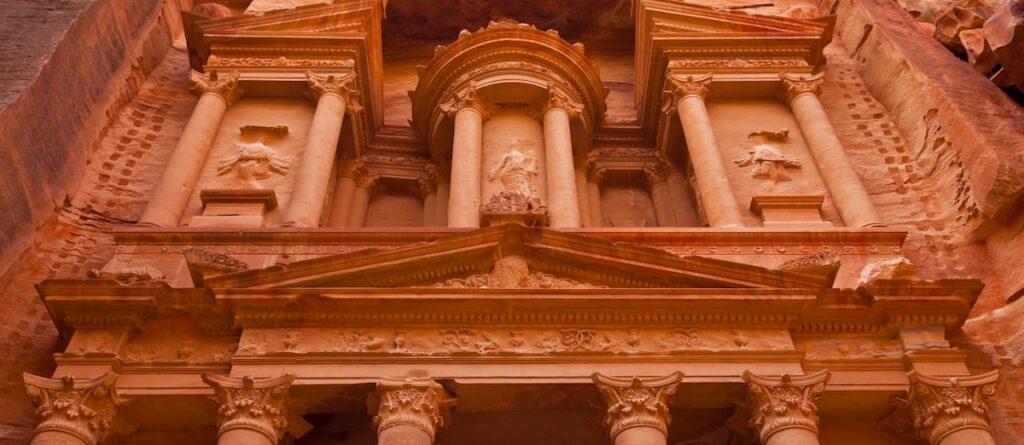
2. The Treasury (Al-Khazneh)
The Treasury, better known as Al-Khazneh, is the very symbol of Petra and a must-see for any tourist in Petra, Jordan, owing to its grandeur. Despite the small Siq lane out to it welcomes you to its other grandeur, an incredibly singular one, as the giant facade cut directly into the rose colored rock material shocks you into disbelief.
At about 40m, the Treasury boasts of all manner of intricate designs with such components as Corinthian columns, sculptures, and carvings that speak to the genius of the Nabataeans, who were also influenced by the Greeks and the Romans. Also known as the ‘Khazneh’ (Arabic for ‘treasury’), it has been wrongly so named since it was not located for storing any kind of treasures; instead, there are still some who believe it was a tomb of a king or a temple erected at about the first century AD.
For the best experience, it is advised to arrive in the morning when the sun is low in the sky and it creates nice lighting on the facade, before the tourists rush in. You can see it directly from the center square, or you may wish to go to the Treasury differently… and climb to one of the platforms provided for magnificent views of the Treasury.
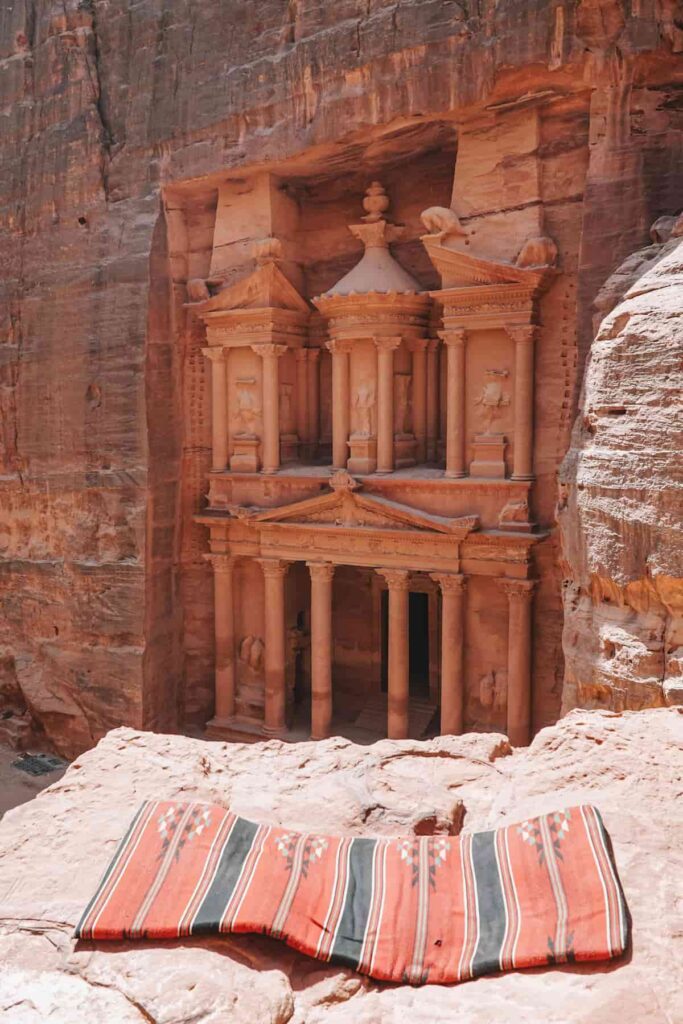
3. The Street of Facades
As you tread further inside this antique city of Petra, one of the primary sectors to come across soon after leaving the Treasury is the street of facades. Moreover, this part is consistently recommended through most Petra Jordan travel guide brochures. Furthermore, it is built along the great towering cliff containing rock-cut structures that include unique tombs and some residences.
Built over the same time as the Treasury were the facades, which still look so opulent. They may not be so ornate as the Treasury, but they are quite impressive as they give a touch of the traditional Nabataean practices in construction and funerary practices. Most of these open fronts were at one time burial chambers for the wealthy populated with several of their members; however, some of them were afterwards transformed to include a living room or store.
Strolling in this narrow passageway gives a feeling of the extensive area that the old city has covered and also allows one to imagine the people who would have once roamed in it. It is also a great spot for any tourist who would like to halt and so as to appreciate the fine details around the sculptures and mainly other aspects of the ones that we have visited, not as a center of Culture but as a settlement daily.
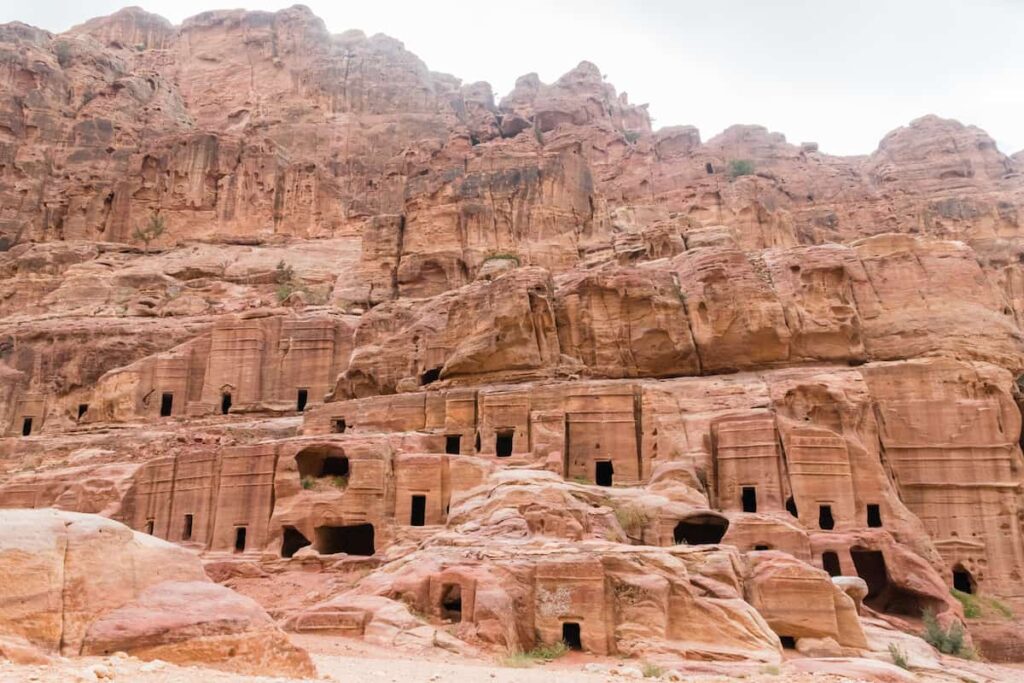
4. The Theatre in Petra Jordan
When it comes to Petra Jordan, another of the city’s standout features unpacked in the guide is the old Theatre, a widespread amphitheater which is entirely constructed and carved from the red cliffs, a color comparable to rose. But the difference from the Roman theaters is that this was not created from the use of individual stone blocks. Moreover, it is rather a detailed, sophisticated project conducted within the rock, which makes it so amazing to see the work the Nabataeans were able to do.
It was, however, equipped for about 6,000 people, that is, spectators. It was prepared for theatre performances, assemblies, or town gatherings, and concerts for the community. With the Theatre, during the Roman era, the viewpoint was adjusted for a larger crowd of people, and some semblance of Roman structural brass invaded the formation.
Imagining the life of the people in the distant past who probably once occupied the seats of this place is easy. It’s not hard to believe that there was more about Petra than simply a city of graves, given the more central part it occupied in a cultural and social context.
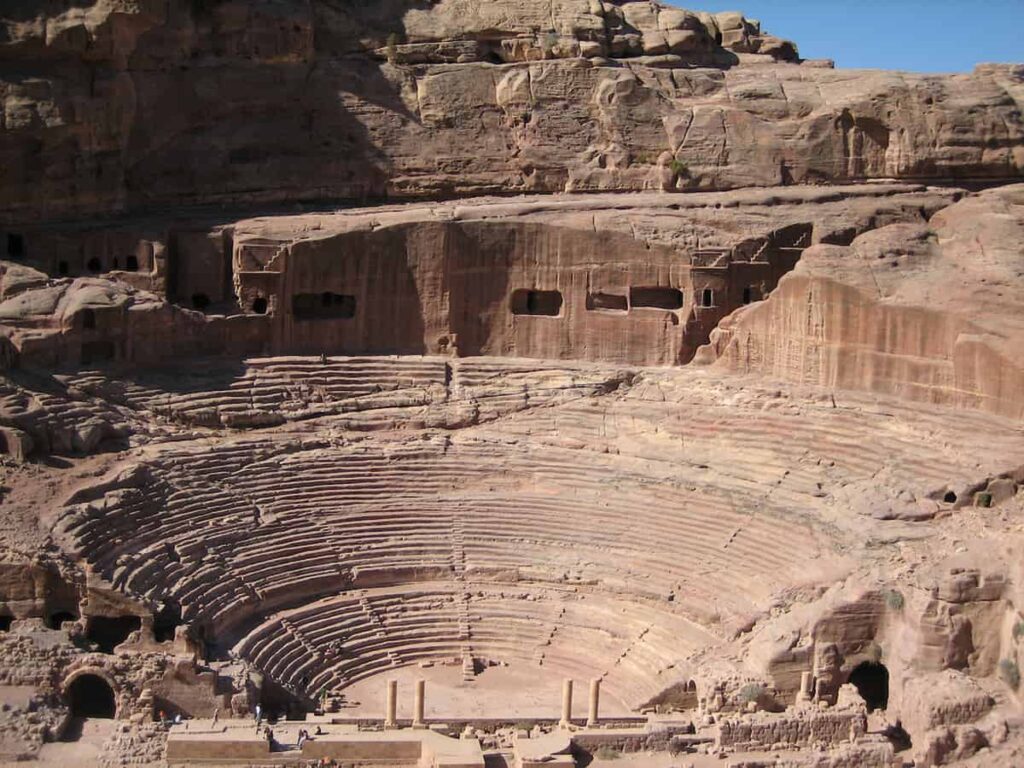
5. The Monastery (Ad-Deir)
The Monastery, or Ad-Deir, is one of Petra’s most impressive things to see, and this short is not complete without mentioning it. To reach this huge structure, a bit of a jout of a hike is needed. Approximately 800 rock-cut steps from the city center is the distance that one has to cover to get to the Monastery. There is the alternative option for those not in the mood for exercise: a ride on a donkey, organized by the lodging owners.
Eventually, all the struggles will pay off. The sight of this behemoth upon your arrival is both awe-inspiring and pleasing. Measuring around 50 meters in width and 45 meters in height, it is one of the biggest and unforgettable structures in Petra. Looking up at the Treasury, this site is both grand and detailed. The Monastery was only an additional structure to the Nabataean civilization and was potentially constructed as a temple.
The Monastery provides beautiful open desert landscapes. You will find here lawns, a cafeteria, and so is a very good place for taking some rest and having a meal from the little Bedouin Cafe located right there. The place is also known for its wonderful setting, especially as the sun sets, which is a magical and epic moment, so do not miss it. At that time, the sunlight is quite gentle and darkens the soft rose rock.
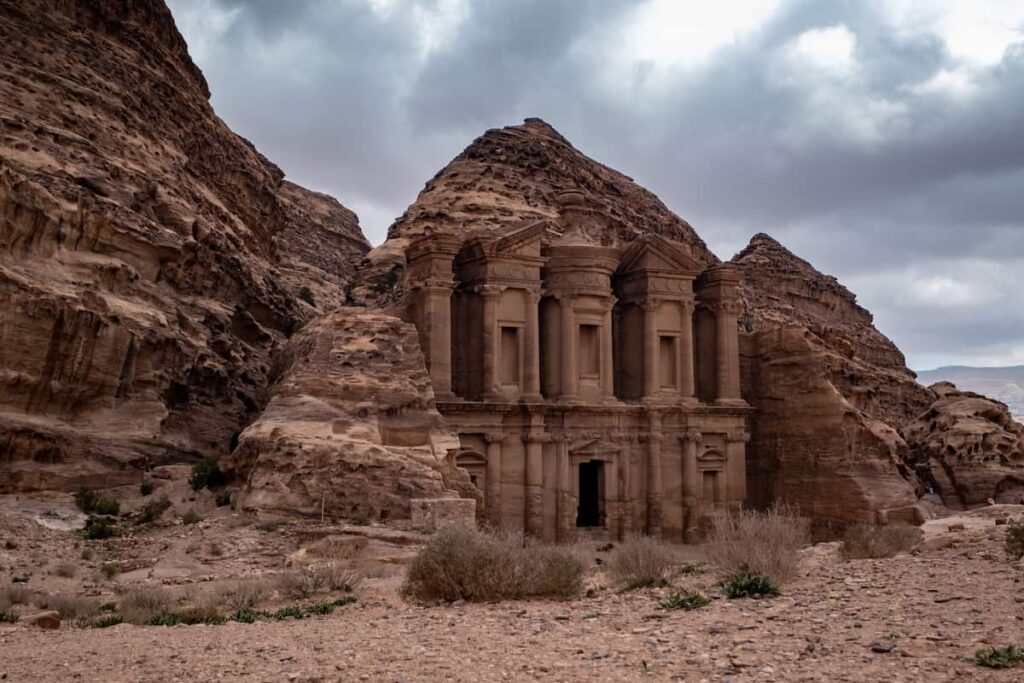
6. High Place of Sacrifice
The second group of people who would like to try the High Place of Sacrifice is this Petra Jordan’s travel guide being less conservative than the first one. This particular area is found far above the ground on the edge of the valley that is filled with the sweet yellow rock and gives an incredible view over the city and into the desert.
The climb to the top will see you go through a well-marked with stone steps but stone-studded trail which should take between 45 minutes and 1 hour depending on how fast you can go. On the way, you will see smaller tombs and eroded remnants of Nabataean rock art. Once you reach the peak, you can visit the available altars and ceremonial podiums where it is claimed that ancient people offered sacrifical gifts.
It is no wonder that the panoramic nature from this place helps one to have a fresh view on how the ‘why’ of Petra fits where it is located. Moreover, this place is an ideal location for photography and embracing the bounty of nature and the man-made tourist attractions of this characteristic, timeless city.

6- Petra By Night Experience With Our Petra Jordan Travel Guide
If you’re looking for a seamless experience that is entirely memorable and ever so enchanting, then consider adding Petra by Night to your travel itinerary. As soon as it gets dark, fine paper lanterns are lit along the path inside the Siq, cutting through the massive structure of red rock and gravel. The sight comprises the Treasury as well, but you will be astonished by the number of lights that have it shining from every angle.
This unique and memorable event always commences on Mondays, Wednesdays and Thursdays at 8:30 PM. Tourists take their seats on large sheets placed on the sand so that they can appreciate traditional Bedouin music and narrative genres. Once upon a time, these events would take place in the day, but now that opportunity is no more and the ancient city is best presented when the sun has gone down.
There is peace contributes to the feeling of being completely lost, almost like nowhere else in the world during the daytime. If you want to see Petra but with less of the crowd and feel something entirely different, Petra by Night is compulsory. Important notes: reservation for this experience must be done in advance, and in some cases, purchased separately, but it should be noted that is only available from the visitor center in Petra or hotels in Wadi Musa.
7- Best Time to Visit Petra
Timing your visit can make a big difference, and this Petra Jordan travel guide highlights the best seasons to explore the rose-red city.
-
Spring (March–May): This is one of the most popular times to visit Petra. The weather is mild, the desert landscape comes alive with patches of blooming wildflowers, and hiking trails are pleasant.
-
Autumn (September–November): Another excellent season, with comfortable temperatures, clear skies, and beautiful light for photography.
-
Summer (July–August): These months are extremely hot, with daytime temperatures often soaring above 35°C (95°F). Exploring Petra in this heat can be exhausting, so if you visit in summer, plan early morning and late afternoon excursions.
-
Winter (December–February): Winters are cooler, and while Petra is open year-round, you may encounter occasional rain or chilly winds in the evenings.
If you want to enjoy fewer crowds, plan to visit early in the morning or later in the afternoon, regardless of the season.
8- Essential Travel Tips for Petra
To make the most of your visit, this Petra Jordan travel guide offers practical tips that will help you explore comfortably and respectfully:
-
Wear Comfortable Shoes: Petra is a vast site with uneven terrain, stone steps, and long walking distances. Good walking shoes or hiking sandals are essential.
-
Bring Water & Snacks: There are a few stalls inside Petra, but they can be far apart and a bit pricey. Carry plenty of water, especially in warmer months, and light snacks to keep your energy up.
-
Hire a Guide: A licensed local guide can enrich your experience with stories, history, and hidden details you might otherwise miss.
-
Stay Overnight: Don’t try to rush Petra in a few hours. Spending a night in Wadi Musa allows you to experience Petra early in the morning or at sunset, when the site is less crowded and the lighting is magical.
-
Dress Respectfully: Jordan is a conservative country. Lightweight, modest clothing is recommended; covering shoulders and knees will make you more comfortable and respectful of local culture.
-
Protect Yourself from the Sun: Bring sunscreen, a hat, and sunglasses. The sun can be intense, even in cooler months.
Following these tips ensures that your journey through Petra is safe, immersive, and unforgettable.
Want to Experience Petra Without the Stress of Planning?
Join one of our Petra tours with Middle East Voyager. From day trips to multi-day packages and private guided experiences, we make your visit seamless, informative, and unforgettable.
9- Where to Stay: Wadi Musa
No Petra Jordan travel guide is complete without advice on where to stay. The town of Wadi Musa, located just outside the main entrance to Petra, is the ideal base for exploring the ancient city. From luxury resorts to budget-friendly hostels, there’s something here for every type of traveler.
-
Luxury: Mövenpick Resort Petra – Located directly across from the Petra Visitor Center, this 5-star resort offers elegant rooms, multiple dining options, and unbeatable convenience.
-
Mid-range: Petra Moon Hotel – Known for its friendly service, rooftop pool, and comfortable rooms, this hotel is just a short walk from the site’s entrance.
-
Budget: Valentine Inn or Petra Gate Hostel – Both are excellent options for backpackers and budget-conscious travelers, providing simple accommodations and a social atmosphere.
Staying in Wadi Musa allows you to be close to Petra’s gates, making it easy to start your visit early in the morning or return after a midday rest.
10- Final Thoughts
While Petra, the city of the Rose Red, even brings in tourists, it is a journey breathlessly taken into history, culture, and a stunning natural environment. Every inch you move here is soaked in history: from the curved Siq and its striking gate to the magnificent Treasury, the huge Monastery, and the expansive High Place of Sacrifice.
The chapter on “Around Petra Jordan Information” explores this city even deeper as it suggests that the place is more than just a mere archaeological wonder, but something that managed to survive during the harshest desert conditions.
Whether one is keen on ancient civilizations, is a photography enthusiast, or is young and looking for fun, all and sundry will surely come back from Petra with a piece of its beauty within themselves. For this, it is essential that one pack their bags and head to Macedonia, and forget about the time it takes to get there. It is the sort of place that one comes back to, long after having left it permanently.
